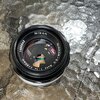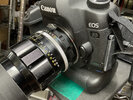I did not know you guys were all into cameras  . HiFi and Shutterbugs have always been birds of a feather -- so should have guessed! For a while now, most product photography I do is shot using a Canon 5d MkII or 6d full frame, and only adapted vintage glass (because it is so good and manual is what I like) . Lately a Nikkor H-C (an old Leica formula update coating from around 72) and often a "Bokina" Vivitar Series 1 90mm for 12ax7 tubes (the lens was popular for dental work!). The idea that new lenses are better for digital is something of a myth. New lenses are good, but old lenses have allot of "micro-contrast" -- something of an urban myth (they say)... but I have compared Apples to Apple in primes....-- in a studio setting they do have something on the new lenses often!
. HiFi and Shutterbugs have always been birds of a feather -- so should have guessed! For a while now, most product photography I do is shot using a Canon 5d MkII or 6d full frame, and only adapted vintage glass (because it is so good and manual is what I like) . Lately a Nikkor H-C (an old Leica formula update coating from around 72) and often a "Bokina" Vivitar Series 1 90mm for 12ax7 tubes (the lens was popular for dental work!). The idea that new lenses are better for digital is something of a myth. New lenses are good, but old lenses have allot of "micro-contrast" -- something of an urban myth (they say)... but I have compared Apples to Apple in primes....-- in a studio setting they do have something on the new lenses often!
Primes are of course the best always, not sure if anyone can debate that much...I have switch to mostly all - still sometimes really enjoy the challenge of finding and using really, really cool all manual zooms... especially for video work. There are some gems from the 70's not many folks know about.
For zooms, I also like some of the all manual Vivitar Series 1 designed by Perkins Elmer (sp) in the USA and made in Japan. These zooms can be finicky, and inconsistent, and at times not as sharp as the latest stuff --- but they sometimes have that "X factor" as dubbed by Hicks/Schultz in the Lens book....
This was a very finicky zoom I still do like allot -- push pull and sometimes it looks like a prime...last two in the list are sample shots from a 5D mk2 (there is CA of course, I don't do any post processing - too much work .
.
I think the CA is what has led me way from vintage zoomers -- but I will continue to use these for video (also on circa 2008 5D mk2) work when I can. They just have "a look" that's cool sometimes.
 . HiFi and Shutterbugs have always been birds of a feather -- so should have guessed! For a while now, most product photography I do is shot using a Canon 5d MkII or 6d full frame, and only adapted vintage glass (because it is so good and manual is what I like) . Lately a Nikkor H-C (an old Leica formula update coating from around 72) and often a "Bokina" Vivitar Series 1 90mm for 12ax7 tubes (the lens was popular for dental work!). The idea that new lenses are better for digital is something of a myth. New lenses are good, but old lenses have allot of "micro-contrast" -- something of an urban myth (they say)... but I have compared Apples to Apple in primes....-- in a studio setting they do have something on the new lenses often!
. HiFi and Shutterbugs have always been birds of a feather -- so should have guessed! For a while now, most product photography I do is shot using a Canon 5d MkII or 6d full frame, and only adapted vintage glass (because it is so good and manual is what I like) . Lately a Nikkor H-C (an old Leica formula update coating from around 72) and often a "Bokina" Vivitar Series 1 90mm for 12ax7 tubes (the lens was popular for dental work!). The idea that new lenses are better for digital is something of a myth. New lenses are good, but old lenses have allot of "micro-contrast" -- something of an urban myth (they say)... but I have compared Apples to Apple in primes....-- in a studio setting they do have something on the new lenses often!Primes are of course the best always, not sure if anyone can debate that much...I have switch to mostly all - still sometimes really enjoy the challenge of finding and using really, really cool all manual zooms... especially for video work. There are some gems from the 70's not many folks know about.
For zooms, I also like some of the all manual Vivitar Series 1 designed by Perkins Elmer (sp) in the USA and made in Japan. These zooms can be finicky, and inconsistent, and at times not as sharp as the latest stuff --- but they sometimes have that "X factor" as dubbed by Hicks/Schultz in the Lens book....
This was a very finicky zoom I still do like allot -- push pull and sometimes it looks like a prime...last two in the list are sample shots from a 5D mk2 (there is CA of course, I don't do any post processing - too much work
 .
. I think the CA is what has led me way from vintage zoomers -- but I will continue to use these for video (also on circa 2008 5D mk2) work when I can. They just have "a look" that's cool sometimes.



 DSC_7455 (2)
DSC_7455 (2)